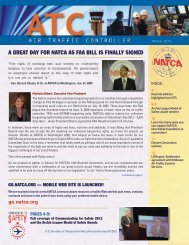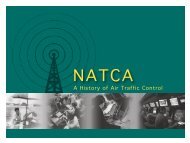Against the Wind - National Air Traffic Controllers Association
Against the Wind - National Air Traffic Controllers Association
Against the Wind - National Air Traffic Controllers Association
You also want an ePaper? Increase the reach of your titles
YUMPU automatically turns print PDFs into web optimized ePapers that Google loves.
142<br />
<strong>Against</strong> <strong>the</strong> <strong>Wind</strong><br />
1992/93<br />
later served as Central Region vice president. “QTP<br />
gave us a façade of working toge<strong>the</strong>r, but tough issues<br />
we never really worked on toge<strong>the</strong>r.”<br />
Paul Williams, a former facility rep at Washington<br />
Center, says QTP<br />
“took away one of our<br />
biggest weapons.”<br />
Williams acknowledges<br />
that cooperative<br />
relationships are possible.<br />
But he also believes<br />
“consensus negates<br />
leadership.” Under QTP’s<br />
committee structure,<br />
one person—ei<strong>the</strong>r in<br />
management or with <strong>the</strong><br />
union—could undermine<br />
a decision everyone else<br />
thought was fine. “It’s led<br />
to a lot of weak decisions,<br />
watered-down decisions,<br />
half-hearted language.”<br />
O<strong>the</strong>rs looked at collaboration differently.<br />
Carol Branaman, who served in leadership roles<br />
with PATCO and was elected NATCA’s Northwest<br />
Mountain Region vice president in 2000, contends<br />
<strong>the</strong> program opened doors for <strong>the</strong> union.<br />
“Everyone maligns QTP, but it was a huge leap<br />
for <strong>the</strong> FAA,” she says. “In many ways, it gave <strong>the</strong><br />
Nov. Jan.<br />
T. Craig Lasker from Boston Center takes over as New England<br />
Region vice president for Jim Breen, who retired as a controller<br />
after suffering a mild stroke and vision loss.<br />
“<br />
Everyone maligns QTP, but it<br />
was a huge leap for <strong>the</strong> FAA.<br />
In many ways, it gave <strong>the</strong><br />
union tremendous influence<br />
that it never had before.<br />
union tremendous influence that it never had before.<br />
It was <strong>the</strong> first time <strong>the</strong>y acknowledged <strong>the</strong> union<br />
had a role in everything that affected <strong>the</strong> facility.”<br />
Barry Krasner notes that <strong>the</strong> law allows both<br />
sides to engage in protracted<br />
disputes over grievances<br />
that can take years to resolve.<br />
QTP provided a way<br />
to settle <strong>the</strong>m faster. Bill<br />
— Northwest Mountain Region<br />
VP Carol Branaman<br />
20<br />
Murphy from Kansas City<br />
Center, who succeeded Mc-<br />
Nally as national QTP coordinator<br />
in 1994, says it came<br />
down to common sense. “If<br />
you beat up someone, what<br />
are you going to get back?<br />
You’ll get beat up.”<br />
Aided by follow-up<br />
training sessions, <strong>the</strong> tenor<br />
of labor relations in <strong>the</strong><br />
FAA gradually improved—<br />
though not everywhere.<br />
But in 1996, QTP was among nine agency programs<br />
totaling $29 million that were cut by <strong>the</strong> Republicancontrolled<br />
Congress as part of its “Contract With<br />
America” to balance <strong>the</strong> budget.<br />
“QTP was not a failure. It left its mark,” says<br />
Howie Barte, who continues to believe in collaboration.<br />
“Where it was successful, it’s still successful.<br />
FAA Administrator Thomas C. Richards leaves after serving<br />
since June 27, 1992. Transportation Secretary Andrew H. Card<br />
Jr. resigns after serving since February 24, 1992.




